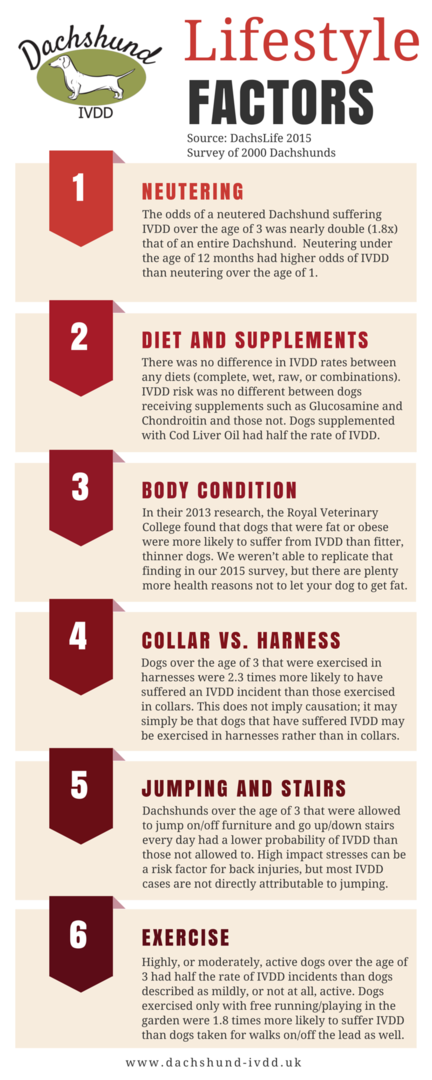
Lifestyle Advice
- Keep your Dachshund fit, not fat
- Adopt a mixed regime of on and off-lead exercise
- Increase the amount of exercise you give your Dachshund as it grows from puppy to adult
- Feed a well-balanced diet, appropriate to your Dachshund's life-stage
- Ask your vet to check if your Dachshund has an ideal Body Condition Score
- Allow your Dachshund to mature fully before considering neutering (unless there is a strong health reason to do this before 12 months)
You are the proud owner of a Dachshund (or maybe more than one!). Can you prevent your dog from developing IVDD? The answer, sadly, is not always, because some dogs are predisposed either through inheritance or shape, but as a responsible owner, you can reduce the risk through the lifestyle choices you make for your dog.
What works for one dog, may not work for another, but the best lifestyle advice is to keep your Dachshund well-exercised, fed a balanced diet and at an ideal body condition (not too lean and not overweight).
In 2015 we conducted a major survey of Dachshunds to identify lifestyle factors that might influence their risk of back problems. You can view the full survey results in a presentation, here.
The survey results were further analysed by a team at the Royal Veterinary College and published in a 2016 peer-reviewed paper which is available here.
There are plenty of anecdotes and advice on how to rear a Dachshund to minimise the risks of back problems, but very little data to support any of these. So, when the results of the survey emerged, there were a few surprises. With responses for over 2000 Dachshunds we had a good sample and were able to draw statistically valid conclusions. However, it is important to remember that “association” is not the same as “causation”; just because we found a relationship between a particular factor and IVDD, doesn’t prove there is a cause and effect linkage.
Some of the results are intuitively obvious and will clearly support long-held views. Others contradict conventional wisdom and, no doubt, some people will be looking for reasons to discount the findings. However, don’t forget that we had a large sample of dogs and are only reporting results that were statistically significant. It’s also worth noting that 89% of the dogs in the survey were purely owned as pets and did not belong to owners in the showing community.
We have summarised the main findings in the pages which you can access from the menu on the left.
The fact that Dachshunds are a short-legged breed remains the biggest causal factor in IVDD because the discs in the spine calcify at a much younger age than in normal-legged breeds of dog. Additionally, IVDD has a strong heritability, meaning it runs in families. Dogs whose parents and other ancestors suffered from IVDD are much more likely also to suffer from IVDD. Unfortunately, just because your dog is fit and in good body condition does not guarantee that it will avoid back problems.
Nevertheless, prevention is better than cure, so lifestyle choices you can take to help reduce the risk of your dog having a back problem are very important. Remember, your Dachshund is a dog and needs to enjoy life as a dog. Over-protecting it and "wrapping it in cotton wool" to try to avoid a back problem will be no fun for you or your dog.


